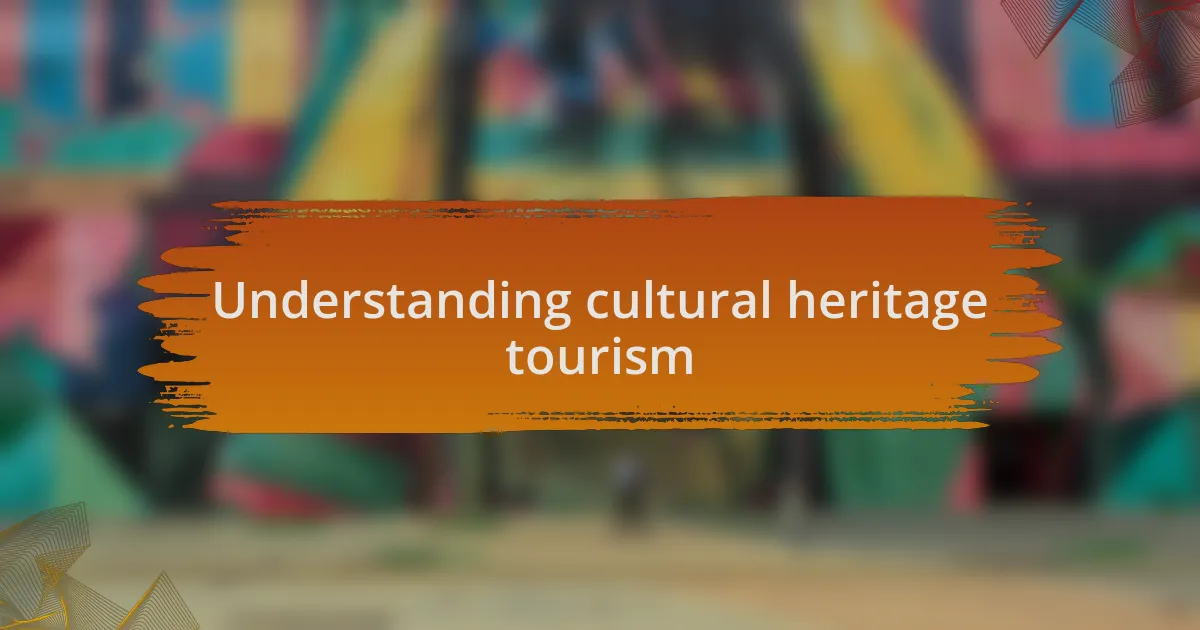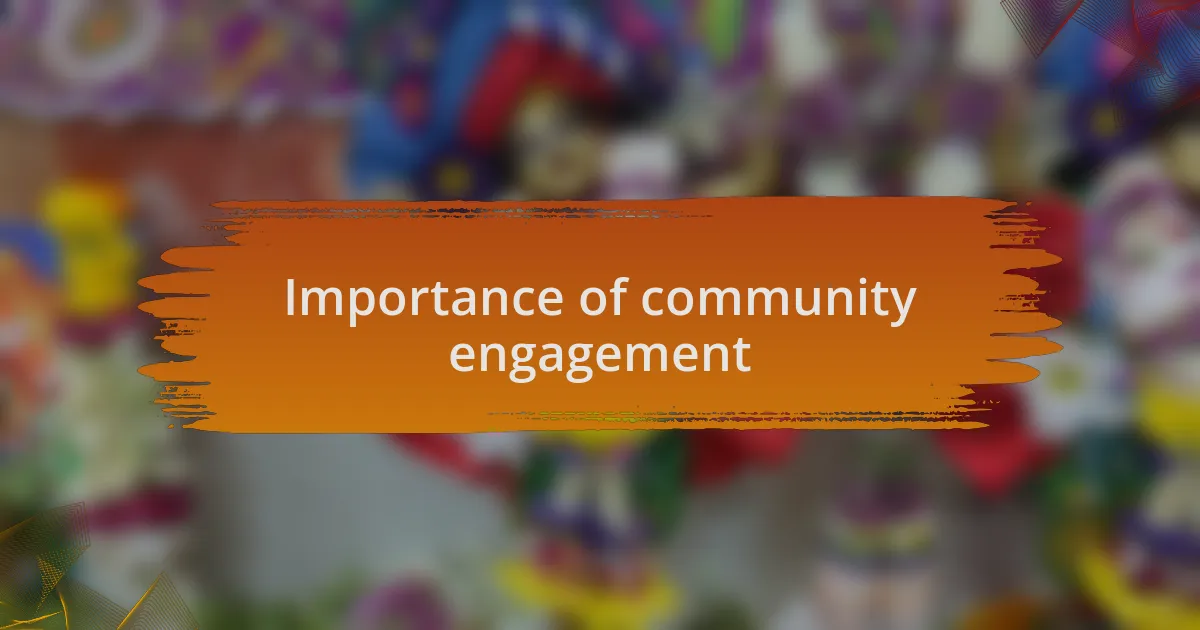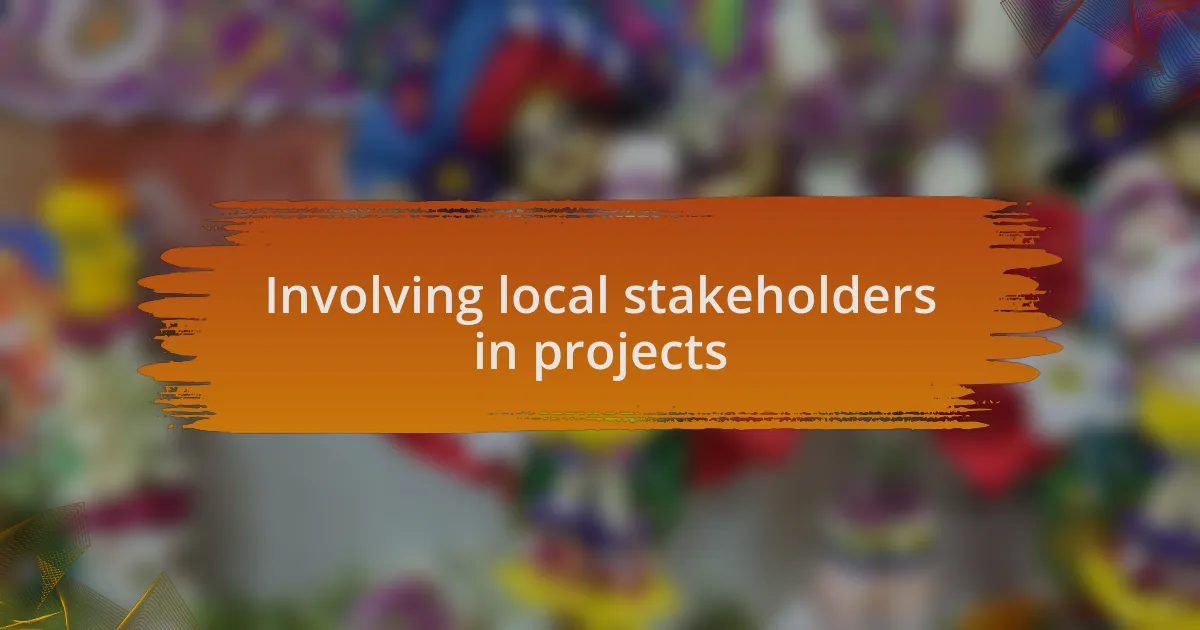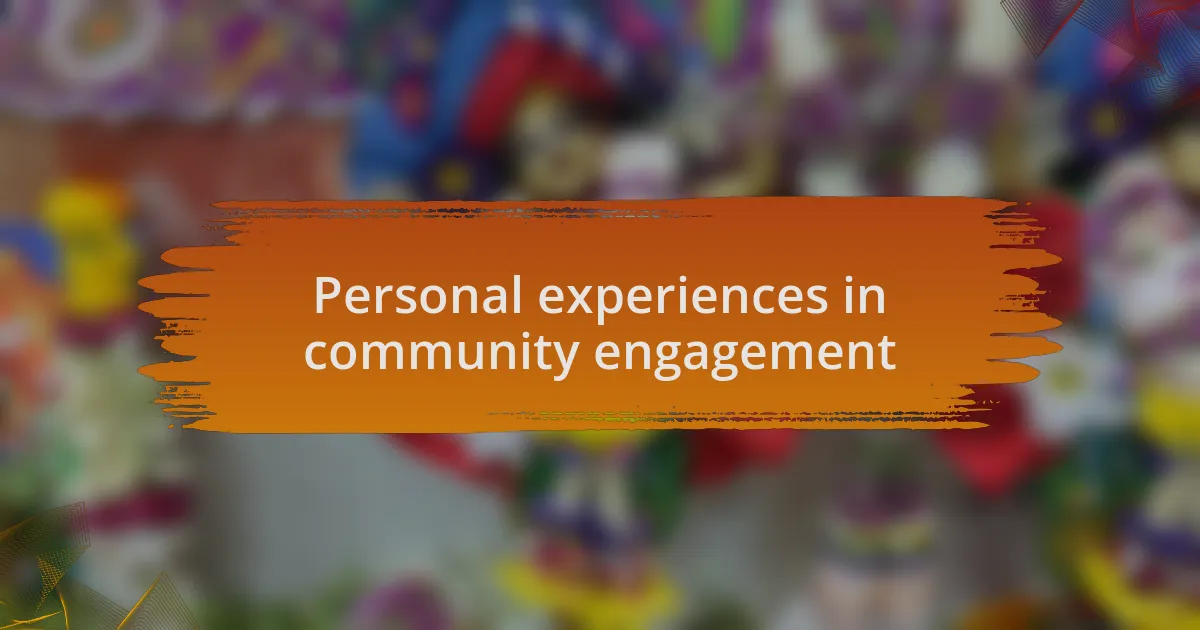Key takeaways:
- Cultural heritage tourism goes beyond sightseeing; it fosters community connection and a sense of responsibility for preserving traditions.
- Community engagement is crucial for successful heritage tourism, enriching visitor experiences and strengthening local bonds.
- Involving local stakeholders in preservation projects cultivates ownership and fosters collaboration, leading to sustainable outcomes.
- Events and workshops can create awareness and inspire a collective commitment to cultural heritage among community members.

Understanding cultural heritage tourism
Cultural heritage tourism is more than just visiting historic sites; it’s about connecting with the stories and traditions of a community. I remember my first experience exploring a local heritage festival. The vibrant storytelling and communal spirit were captivating, making me think: how often do we step outside our daily routines to truly appreciate the narratives shaping our surroundings?
When travelers seek to immerse themselves in the fabric of a culture, they engage with it on a much deeper level. I often find myself reflecting on the conversations I’ve had with local artisans. Their insights not only highlight the significance of their craft but also remind me of the intricate link between culture and identity. Isn’t it fascinating how one piece of art can tell a thousand stories?
Engaging in cultural heritage tourism fosters a sense of responsibility towards preserving these treasures. I once organized a neighborhood cleanup before an annual cultural fair, and the sense of pride among residents was palpable. It made me wonder: how can we encourage more communities to take ownership of their heritage? This kind of involvement enriches the tourism experience, creating a lasting impact for both visitors and locals.

Importance of community engagement
Community engagement is vital for the success of cultural heritage tourism. I’ve seen firsthand how involving locals in tourism initiatives not only enriches visitor experiences but also strengthens community bonds. When I participated in a workshop where residents shared their stories, it struck me how these narratives breathed life into the cultural sites we’d only scratched the surface of before.
Moreover, when communities take charge of preserving their heritage, they foster a sense of ownership and pride. I recall a time when a group of passionate locals collaborated to restore an old building that held memories for many, including myself. Witnessing that transformation felt like watching a piece of our shared history come back to life—doesn’t that create a powerful connection to place?
Engaging the community in cultural heritage tourism ignites a collaborative spirit that can drive sustainable tourism development. During a town hall meeting about a planned cultural fair, residents voiced their ideas and concerns, shaping the event into something truly reflective of our unique identity. Isn’t it incredible how open dialogue can turn a simple event into a celebration of community spirit?

Strategies for effective preservation
When it comes to effective preservation, building partnerships is essential. Early in my journey, I organized a collaborative project with local artists to create murals that represented our cultural heritage. This initiative not only beautified our shared space but also engaged the community in a creative dialogue about identity and history—don’t you think art has a unique ability to spark interest in preserving our roots?
Another strategy I found effective is educational outreach. I remember attending an after-school program where the kids learned about their local heritage through storytelling. Their excitement was palpable; it was clear that instilling an appreciation for history in younger generations encourages a long-term commitment to preservation. How can we expect the future stewards of our heritage to care if we don’t actively involve them in the process?
Lastly, leveraging technology can play a pivotal role in preservation efforts. I once helped launch a virtual tour of our historical sites, which allowed many who couldn’t visit in person to experience our culture. The responses we received were heartwarming—people were eager to learn more, prompting discussions on how they could contribute to preservation efforts. Isn’t it fascinating how technology can bridge gaps and create new opportunities for engagement?

Creating awareness through events
Events can serve as powerful vehicles for creating awareness about cultural heritage. I recall hosting a festival that featured traditional crafts, music, and storytelling. The atmosphere was electric, with families gathering to experience the vibrancy of our heritage firsthand. Watching children dance to folk music ignited a sense of pride within me—don’t you think shared experiences like this can nurture a deeper connection to our roots?
Moreover, I organized workshops where local historians shared captivating tales of our community’s past. Attendees left feeling inspired, armed with knowledge that they felt compelled to pass along. It’s incredible how a simple event can transform strangers into advocates for preservation—don’t you think that when one person gets excited about history, it can ripple through the community?
I also partnered with local schools to create heritage days, where students showcased what they learned about our cultural traditions. The energy from those young minds eager to share their projects was contagious! Their pride fueled conversations among parents and community members, turning a single event into an ongoing dialogue about cultural preservation. Isn’t it remarkable how such initiatives can spark curiosity and foster a communal sense of responsibility toward heritage?

Involving local stakeholders in projects
Involving local stakeholders in preservation projects is essential for fostering ownership and commitment. I once collaborated with a local farmer’s cooperative on a project to restore traditional agricultural practices. Their firsthand knowledge and passion for the land were invaluable. Engaging them in discussions about which crops were historically significant not only honored their expertise but also deepened our understanding of how agriculture shapes cultural identity. Isn’t it fascinating how everyday practices can hold such deep historical significance?
I remember a particularly rewarding experience with a group of artisans who were instrumental in reviving ancient crafting techniques. By inviting them to lead workshops, we created a space where their voices were amplified, and participants could engage directly with master crafters. Watching the artisans teach the next generation was a poignant reminder of the vital role they play in preserving our heritage. Don’t you think it’s important that we highlight these talents, allowing their stories to flourish in our community narratives?
Further, I found that involving local government representatives in our preservation projects led to more sustainable outcomes. They provided not only resources but also valuable insights into policy implications. During a community meeting, when they expressed support for our initiatives, the energy in the room shifted—people felt heard. It was a powerful moment that reinforced my belief that when local officials engage with community members, it fosters a collaborative spirit essential for preservation. Have you noticed how strong partnerships can shape the success of such endeavors?

Personal experiences in community engagement
Engaging my community has often led to unexpected yet rewarding moments. I vividly recall a day when I organized a storytelling event at our local library, inviting elders to share their memories of the town’s founding. The room was filled with laughter and nostalgia, and I was struck by how their tales created an instant connection among attendees, transcending generations. It made me realize how crucial these narratives are in shaping our collective identity, doesn’t it?
On another occasion, I invited local schoolchildren to participate in a mural project that depicted our community’s history. As I watched them paint, I was reminded of the enthusiasm they brought and how this experience sparked their interest in cultural heritage. Their faces lit up with pride when they saw their work celebrated at a community gathering. Isn’t it wonderful how engaging the younger generation can cultivate a sense of belonging and responsibility toward preserving their heritage?
Additionally, I believe that fostering community engagement often hinges on creating safe spaces for dialogue. During a neighborhood cookout, I initiated conversations about the importance of cultural preservation and listened attentively to varied perspectives. The genuine exchanges that unfolded showed me how vital it is to recognize differing viewpoints while uniting around a common cause. Have you experienced how powerful conversations can lead to unexpected alliances in our efforts to preserve what matters?